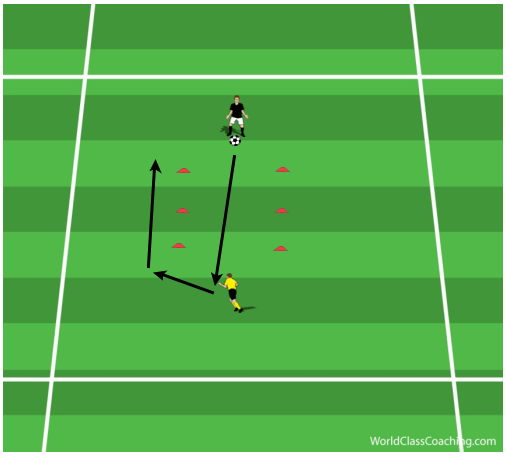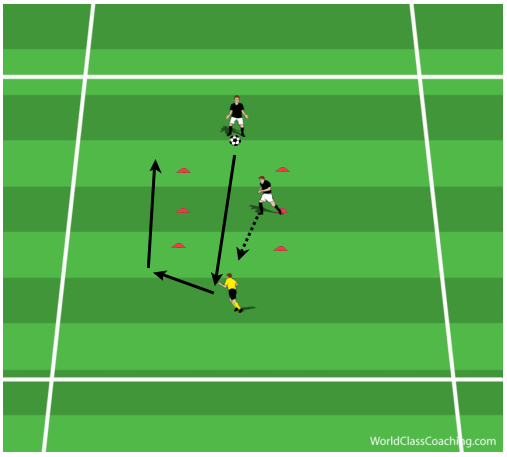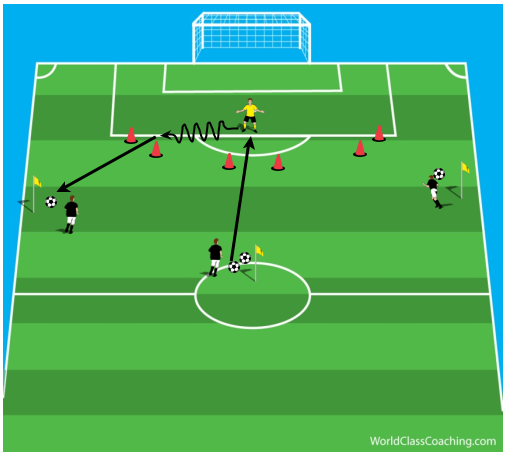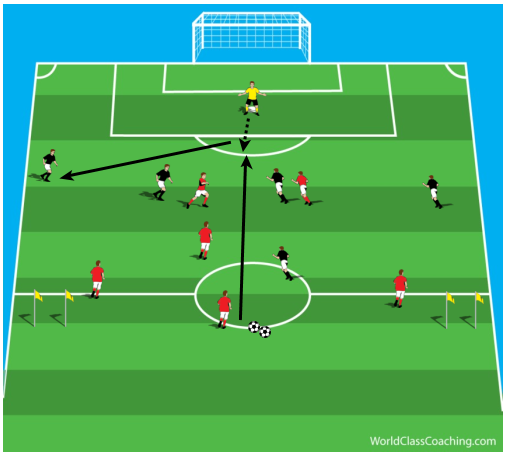By Tony Englund -
Among the more challenging tactical teaching topics for goalkeepers is helping them to control their area. There are numerous moments in the game when the goalkeeper’s ability or inability to eat up loose balls in the area can swing control of the game to one team or another. Crosses, through-balls and balls that fall loose to the ground in the area when the opponent is attacking all present challenges, as do back-passes when the ‘keeper’s own team is in possession. In article #1, key teaching cues for teaching the goalkeeper to deal with crosses were discussed. This article will take a look at the importance of through-balls and back-passes for the goalkeeper and the back line.
Technical Training for Dealing with Back-Passes
When we teach goalkeepers to deal with back-passes, it is useful to begin at the technical stage, emphasizing quality touches, changing the angle on the ball and accurate distribution. In the base exercise above, the coach passes balls for the goalkeeper to receive at the end of a lane.
Coach
- The goalkeeper must take a first touch that is positive (forward) and outside of a hip (change the angle of the ball) and play back to the server through a different lane as shown. The angle change is critical so that any on-rushing attacker will not be able to block the goalkeeper’s pass.
- Practice receiving both with the inside and outside surfaces of each foot. Note that with the inside surface, one can play either direction with either foot, whereas with the outside of the foot, one must play to the near side.
- Cut the time between the receiving and passing touches for efficiency.
Progression
- Vary the service, increasing pace, playing on a bounce or in the air (can the goalkeeper head the first touch if necessary?).
- Add a chaser who runs at the goalkeeper to provide increasing pressure. Adjust the pace and distance the player runs to provide useful pressure for the goalkeeper.
Exercise Training Receiving and Distribution for Accuracy in a Functional Setting
The exercise below puts the goalkeeper in the 18-yard box (functional setting) and adds targets for the goalkeeper to play to after receiving.
Use three servers (or one and three flags). The ball is served from any of the starting points and the goalkeeper must quickly receive and play through a different cone gate to a target or flag.
Coach
- This exercise puts the goalkeeper in a functional setting, working near the top of the box and controlling balls served in, trying to change the point of attack.
- Receive the ball as early as possible and make sure the first touch is angled and forward to facilitate distribution as quickly as possible.
- Remind the goalkeeper that in an emergency, high, wide and far distribution (in that order) are desirable to limit the possibility of the ball being blocked or sent back in before he can recover to his goal area.
Progression
- Vary the distance and pace of serves, play bounces and serves in the air. Can the goalkeeper step beyond the box and head away if necessary?
- The server follows his pass and applies pressure (acting as an opponent). This progression adds some pressure to the goalkeeper’s work. Encourage the goalkeeper to measure the pace and requirements of the serve (do you need to settle the ball?) with the approach of the runner while the ball is traveling to decide how many touches may be played and the angle required for safe distribution.
Dealing with Through-Balls and Back-passes in a Game Environment
This is a 6 vs. 5 plus goalkeeper game. The goalkeeper’s team features a back four and a target striker. His team plays to the two counter flag goals. They must dribble through the goal to score. The opponents play a back line of three (with a center back who serves balls to restart play), a central midfielder and a pair of strikers. If this group win the ball, they play to goal. Note that all restarts are taken by the center back from the back edge of the circle and this player can serve over the top (through ball) for the goalkeeper and back line to defend or play to one of the backs, who are required to play to the goalkeeper before going forward. This setting creates a realistic environment for the coach to train the goalkeeper and the back line to cooperate in controlling the back third through dealing with through passes and playing back-passes.
[wpsharely id="821"][/wpsharely]Variations
- Touch limits for the target back line players and especially the goalkeeper (i.e. two-touch). Can they still control play?)
- Encourage the back line players to probe one side of the field, then reverse play through the goalkeeper. Note that this movement requires the goalkeeper to move up field a bit and remain connected to the his team in possession.
- Add another attacker for the red team (3-front) to apply more pressure to the goalkeeper and back line.
- Begin the sequence with a pass into a red forward, who lays off for the midfielder to play in behind. This sequence holds the back line and forces the goalkeeper to read play with more pressure.
- Require the goalkeeper to play the target striker for a few repetitions. The target should be active, moving up and down and across the field. This variation compels the goalkeeper to play longer and with accuracy out of the back.
There are many ways to expand the goalkeeper’s range and prowess in dealing with back-passes and through-balls and this series is a flexible, logical means of providing intensive training for the goalkeeper in key aspects of this critical component to team defending and possession.
By Tony Englund - Holds an NSCAA Premier License and 11 other diplomas. Tony has presented goalkeeping clinics for the NSCAA and is the author of six books including: Goalie Wars! and Art of the Duel






